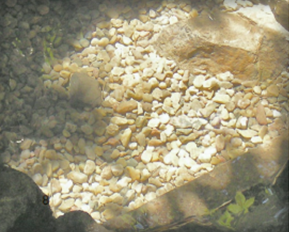Clean a spring or well
Since ancient times, people have settled around rivers, lakes or springs. In short, wherever water was available. Life-giving spring water. Many of you probably know how refreshing it is to take a few sips of such water after a long journey. However, small wells have enriched our landscape not only with the opportunity to drink from them, but have been a fixed part of it since man began to care for them.
(Natural) well
We can find hundreds of wells in many forms in the countryside. Whether it is a small depression where a spring springs up, or a pipe from which water gushes, it always depends on our feeling whether to interfere with the current visual and technical state of the well.
In the case of small wells, it is often enough to carry out basic maintenance, to put stones or wood treads so that the edge does not get muddy, and to clean the bottom. And if we want people to go to the well, we can perhaps install signposts. If the situation requires it, then the well can be roofed, its sides reinforced, a stone filter placed at the bottom or a seating area or an information board created around it. Of course, these measures cannot be done without the consent of the owner and manager of the site, or other permits.

Wells with built construction
In particular, wells in important places, in villages or wells with some reputation used to be accompanied by a chapel, statues or a building that emphasized its importance in the surrounding area.
If we are not experts in the reconstruction of monuments, we prefer to avoid such wells, with the exception of basic cleaning. Or we can provide professional supervision that manages the entire event.
Many such wells are declared monuments. That is why we always find information about maintenance and repair options at the relevant authorities.

Care of wells
If we would like to take care of the well more widely, it is wise to make an agreement with the owner or manager of the land.
Information on land ownership can be found in several ways:
We will search for the land where the well is located and then the address of the owner. The cadastral office provides this information online or at its branches. More detailed information about a specific well can be obtained from local residents living in the vicinity of the well, at the local municipal or city office. Forest wells are also often managed by forest managers or administrators of protected areas.
Major modifications and interventions in the well and its surroundings must be agreed with the relevant water authority. In most cases, there is no problem with this, and we obtain consent from the owner and the authority.
Bottom cleaning
The first thing we do is clean the bottom of the well from attacked and washed-up dirt. These are mainly leaves, fruits, twigs, grass, but also various invertebrates.
The soft deposits at the bottom of the well can be picked very carefully. Sometimes ash is enough for this, but commonly available tools such as a mason’s scoop („fan“) or a large shovel are better. At the same time, we must be careful that there is no stone filter at the bottom of the well. If so, we take out the stones, remove the dirt on the bottom and then either insert the original stones (but rinsed) or use new stones.
This filter can be made from pebbles collected in the surroundings or you can buy a so-called „kačírek“, which can be found in building materials or hobby markets. We layer stones all over the bottom to a height of approximately 10 cm.
An absolutely fundamental rule that we must follow and which applies to all wells: When cleaning the well, we do not deepen the bottom! By unprofessionally deepening the bottom, we can damage its impermeable layer and water can be lost.
If cleaning the bottom will be our only modification, then at the same time we will make the water drain from the well passable and clean its surroundings. They are simple activities that require hands, gloves, good shoes, a saw, scissors, a rake or a hoe.

Sides of the well
The sides of the well can easily be made of soil overgrown with plants. In this case, we only lightly clean the edges so as not to destroy their natural shape. On the access side, we adjust the soil so that its edges do not tear into the water. There are many options. Laying flat stones as stepping stones, dumping small stones, but also laying weaker logs or creating a hut (laid bundles of branches). If small roots grow into the well, we usually do not remove them, we just shorten them. The roots limit the erosion of the side walls of the well, and they also filter the water.
We reinforce the sides of the well with various materials so that the earth does not float into the water, its surroundings do not become muddy, and possibly also to serve as a foundation for the roof of the well. We most often use stone collected in the surroundings. When folding it, the basic row needs to be placed on a stable base – something that distributes the weight so that the bottom of the well does not break through. We lay the stones in individual rows with the flat side down, we fill the resulting gaps with smaller stones. We put the next row „on binding“. We end with the top row, which protrudes slightly above the surrounding terrain. The stone is best laid „dry“, i.e. without mortar or concrete. We can erase the joints between the stones with clay so that water does not flow into the well when it rains. In addition to stones, wood can also be used to strengthen the sides of the well. Core oak wood lasts the longest, however we build most often from what is available. There are many ways to use wood – from stacked balls, landscape boards to planks or planks. We should remember to debark the wood along its entire length to make it last longer. To strengthen the sides of the well, we can also use other building materials – bricks, blocks, concrete products, etc. However, they must always be certified for use in damp or drinking water.
In some cases we use concrete rings. Be segmented, usually made of five parts that fit into „locks“ against each other. Or whole, circular. Their use is limited by the possibilities of transport and the physical strength of the builders.

Roofing of the well
Roofing is important when we don’t want leaves or other organic material to fall into the well. Roofing can take many forms. From a free-standing roof made of stone to a dome through wooden roofs of various shapes to masonry roofs made of stone, bricks or other materials.
We choose the size of the roof in proportion to the size of the well and use as few artificial materials as possible. Not only do they not fit into the natural environment, but they can also break down over time and release poisonous substances into the surroundings of the well.
Usually, a roof made of planks is enough, which we treat with a suitable coating (for example, wooden terr).
What about the water during the repair
During repairs, the water in the well usually won’t bother us. But, for example, when removing mud from the bottom, it is sometimes better to take water from the well. Most of the time, it is enough to „throw“ the water out with a shovel, but sometimes we have to use a bucket or even a pump.
After the completion of all construction work, we will remove the cloudy water in the well. It is often a never-ending job: we simply pick until the water is clear.
Water purity
We have to realize that water in wells is usually susceptible to many pollutions, both natural and man-made. How far the water in the well can be harmful to health can be estimated based on experience, mainly based on what its surroundings look like. Water pollution by algae, nearby garbage dumps, dead animals, the proximity of industrial or agricultural operations give us a signal that we should not drink the water. We should also be careful if the well is located near an animal mud pit, a wetland with stagnant water, a large agricultural area with intensive plant or animal production, etc. Fecal waters from the village or cottage areas also often enter the well.
If there are no potential risks in the vicinity, then we can drink the water with caution, but we prefer to treat it by boiling it. If we would like to drink water from the well regularly, then we clearly have to send a sample for analysis.We can only find out whether the water in the well is drinkable, or better said „safe for health“, only through laboratory analysis. Such an analysis is provided by many accredited laboratories. Their list can be obtained from the regional public health authority.
However, we think that the water analysis corresponds to the moment when the sampling was carried out.
